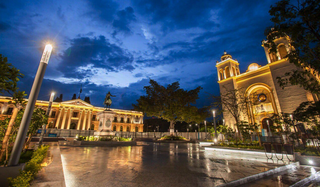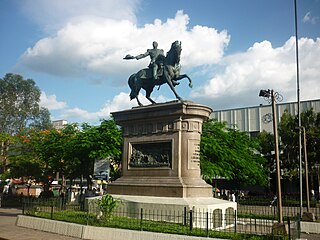
San Salvador is the capital and the largest city of El Salvador and its eponymous department. It is the country's political, cultural, educational and financial center. The Municipality of San Salvador has 209,633 inhabitants (2020). The Metropolitan Area of San Salvador, which comprises the capital itself and 13 of its municipalities, has a population of 2,404,097. The urban area of San Salvador has a population of 1,600,000 inhabitants.

The Liberation Tower is a 372-meter-high or 1,220 feet tall telecommunications tower in Kuwait City, Kuwait. It is the second-tallest structure in the country and the 39th tallest building in the world. The tower is not publicly accessible to tourists. However, the complex building attached to the tower houses government offices such as the Communication and Information Technology Regulatory Authority and a government service center that offer civil services related to Ministry of Interior, Ministry of Foreign Affairs, Public Authority For Civil Information, Ministry of Justice, Public Institution for Social Security, Ministry of Commerce and Industry, Fire Service Directorate, and Ministry of Social Affairs and Labour.

The Legislative Assembly is the legislative branch of the government of El Salvador.

Casa Presidencial, or "Presidential House" in the Spanish language, is the President of El Salvador's official residence and his offices.
Nueva Granada is a municipality in the Usulután Department of El Salvador. According to the official census of 2007, it has a population of 7,451 inhabitants.
Agua Caliente is a municipality in the Chalatenango department of El Salvador.

Estadio Óscar Quiteño is a multi-purpose stadium in Santa Ana, El Salvador.

Acajutla is a seaport city in Sonsonate Department, El Salvador. The city is located at 13°35′24″N89°50′01″W on the Pacific coast of Central America and is El Salvador's principal seaport from which a large portion of the nation's exports of coffee, sugar, and Balsam of Peru are shipped. As a city, Acajutla is one of seventeen such districts in Sonsonate. As of 1992, the population of the city was 18,008.

San Andrés is a pre-Columbian site in El Salvador, whose occupation began around the year 900 BC as an agricultural town in the valley of Zapotitán in the department of La Libertad. This early establishment was vacated by the year 250 because of the enormous eruption of the caldera of Lago Ilopango, and was occupied again in the 5th Century, along with many other sites in the valley of Zapotitán. Between 600 and 900 AD, San Andrés was the capital of a Maya polity with supremacy over the other establishments of Valle de Zapotitán.

The Metropolitan Cathedral of the Holy Savior is the cathedral church of the Catholic Archdiocese of San Salvador in San Salvador, El Salvador.

The Philippine Center is an agency of the Philippine Government in New York City and San Francisco in the United States. The New York City structure houses the Philippine Mission to the United Nations, the Philippine Consulate General, and the overseas offices of the Department of Trade and Industry and the Department of Tourism. The Philippine Center Management (PCMB) manages the building and its properties. It is committed to "nurture, promote, and propagate Philippine culture, encourage foreign tourists to visit the Philippines, expand foreign markets of Philippine products, and enhance the image of the Philippines."

Tashichho Dzong is a Buddhist monastery and fortress on the northern edge of the city of Thimphu in Bhutan, on the western bank of the Wang Chu. It has traditionally been the seat of the Druk Desi, the head of Bhutan's civil government, an office which has been combined with the kingship since the creation of the monarchy in 1907, and summer capital of the country. In old British documents, it is known as Tassisudon.
It was built by the first Dharma Raja, who also founded the Lho-drukpa sect of Buddhism, which has remained the distinctive sect of Bhutan. The correct transliteration of the vernacular name—Bkrashis-chhos-rdzong, meaning "the fortress of auspicious doctrine"—is, according to Graham Sandberg, Tashichhoidzong.

The Saint Augustine House is a landmark building located in the Historic center of Mexico City, on the corner of the streets Republic of Uruguay and 5 of February,.

The Libertador Building is a government building in Buenos Aires, Argentina, housing the Ministry of Defense.

The Islas Marías make up an archipelago in Mexico, consisting of four islands. They are located in the Pacific Ocean, some 100 km (62 mi) off the coast of the state of Nayarit and about 370 km (230 mi) southeast of the tip of Baja California. They are part of the municipality (municipio) of San Blas, Nayarit. The islands were used as a penal colony until February 18, 2019, when President Andrés Manuel López Obrador ordered the closure of its operation as Islas Marías Federal Prison.

The San Salvador historic downtown includes the area where the capital city of El Salvador has been located since the 16th century. This district has long been the country's political, economic and religious center.
The municipal districts of San Salvador, the capital city of El Salvador, are naturally delimited by the Acelhuate River on the east, the San Jacinto Hill on the south east, the lower highlands of the Balsam Range on the South, El Picacho Mountain and the Bicentennial Park on the West, and North by the San Antonio River. The municipality is further subdivided into Districts governed by the municipal mayor and by a district board. There are seven districts in San Salvador, districts 1-6 and the Historic Downtown.
The following lists events that happened during 1971 in Chile.

The Hospital El Salvador is a major hospital in San Salvador, El Salvador, which was planned to be the largest hospital in Latin America. The first phase was constructed between March and June 2020 as a conversion of the International Fair and Convention Center and formed part of El Salvador's response to the COVID-19 pandemic, exclusively receiving COVID-19 patients. Originally intended to be temporary, it was announced in June 2020 that the hospital conversion would be made permanent. In its first phase, the hospital has 400 available beds, a number which was expected to increase to 2,000 total beds upon completion of phase 3 of construction. However, phase 3 was not opened as a hospital and instead served as a vaccination facility. With the decline of the pandemic, the facility has been announced as the home for a new medical school and also houses offices for the Salvadoran health ministry.

The Plaza Gerardo Barrios is a plaza in the historic center of the city of San Salvador, El Salvador.















